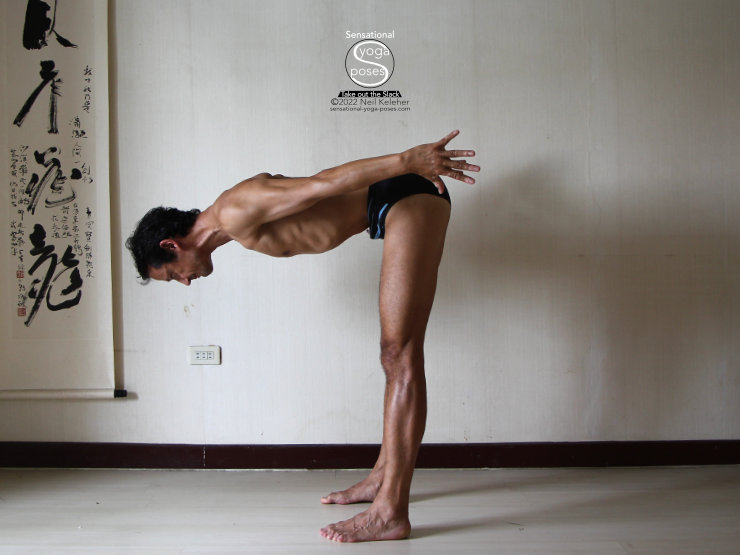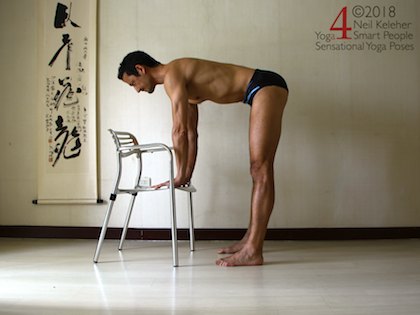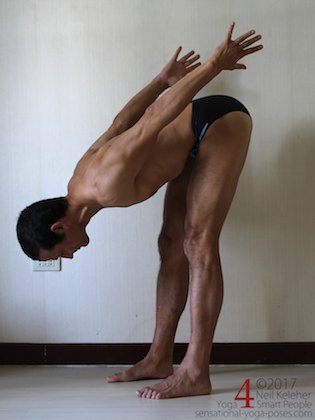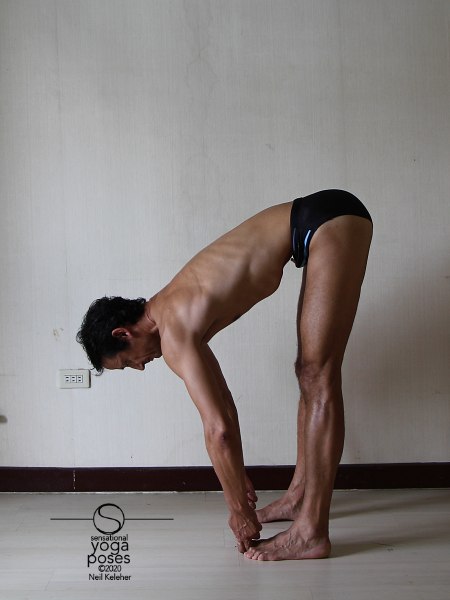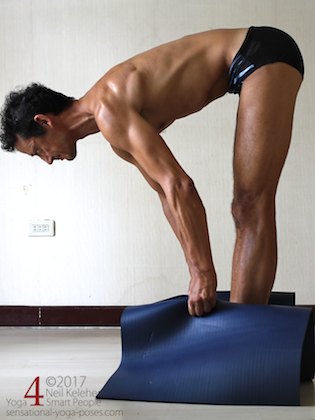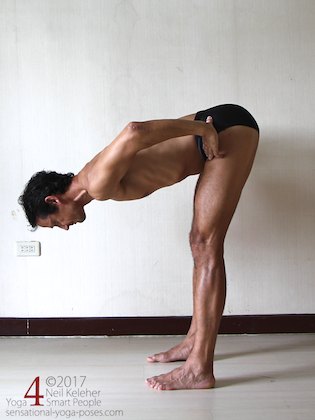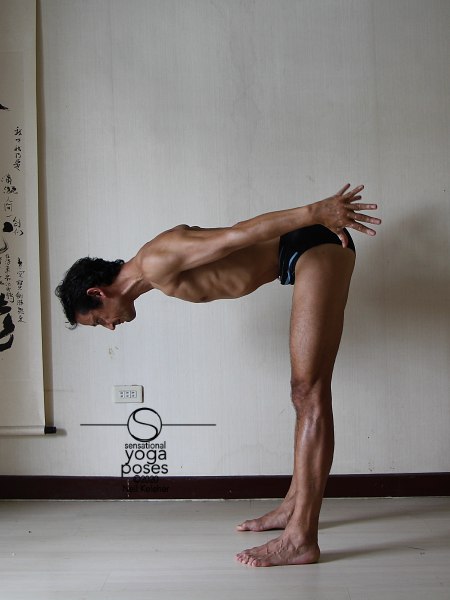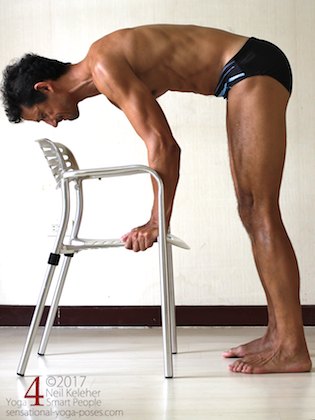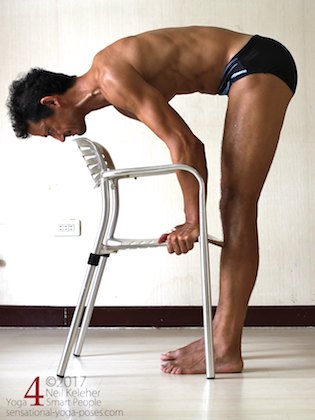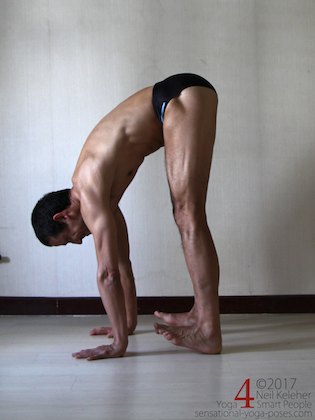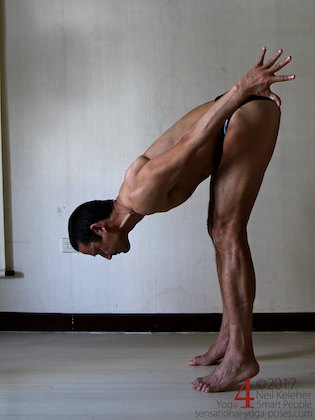Standing Forward Bend
Stretch and strengthen hamstrings, glutes and calves
Bending forwards at the hips, you can do a standing forward bend.
You can use this action to stretch the hamstrings and/or strengthen them.
If you can't reach the floor, an option for standing forward bend is to use a chair or yoga blocks.
Standing forward bend index
Related
In a standing forward bend the feet can be hip width apart or together. In either case the knees are straight but the hands can be supported (on the floor or on a chair or yoga blocks) or lifted.
For hip and knee comfort you can experiment with turning the feet slightly outwards or inwards (not shown).
With respect to using the hands in a standing forward bend. They can be on the floor (not shown directly above). They can be :
- Gripping the big toes
- or slid under the feet.
- You could also grip behind the ankles (not shown) or even grip onto your matt.
Any of these options can be used as a way of strengthening the arms while doing a standing forward bend.
Note:
- The big toe gripping option is called padangusthasana. In ashtanga yoga the usual technique is to grab the big toes with the first two fingers (index and middle fingers) and the thumbs with the palms facing inwards. You could experiment with using the last two fingers.
- The hands under the feet option is called padahastasana. It too is used in the ashtanga yoga standing sequence. The palms face upwards with the fingers pointing back.
In all of the above options you can use your arms against your legs to add tension and feeling to your standing forward bend.
You can also do a standing forward bend with the hands not on the floor:
- either being held relaxed behind the back,
- unclasped and reaching backwards (or upwards),
- or clasped and reaching backwards or upwards, away from the back of the body.
Doing the relaxed hands behind the back option you could focus on your legs, particularly your hips, trying to make them active.
Reaching the arms, whether unclasped or clasped, you could focus on making your arms feel long. This may help you to activate your latisimus dorsai muscle (and other arm and shoulder muscles). But the lats can be particularly important since they attach to a large portion of the spine and in addition attach in part to the opposite gluteus maximusmuscle via the thoracolumbar fascia.
Note the differences in sensation in the hips and legs when the hands are on the floor (or chair or yoga blocks), versus with the hands not on the floor.
With the hands on the floor you should find it easier to relax your legs since your hands can help support the weight of your upper body.
And so to train your legs, and your hip muscles, it can be a good idea to learn to do a "hands-free" version of the standing forward bend.
Lengthening Your Spine while Doing Standing Forward Bend
In any of the above options you can focus on lengthening your spine.
I would suggest not worrying about maintaining the natural curves of your spine while doing this. (Since they are natural, they will resume when you relax your spine.) Instead, focus on making your spine feel straight and long.
The three main parts of the spine to focus on in this regard are:
- the cervical spine (the neck),
- the thoracic spine (the part that the ribs attach to)
- and the lumbar spine (the part that connects your ribcage to your pelvis.)
This can feel like a mixture of stretching your spine, but making it feel strong at the same time. So it may take some practice.
As mentioned, when doing a standing forward bend with hands lifted, whether unclasped or clasped (but not on the waist) you also have the option of making your arms feel long. You may find that if you do this after lengthening your spine, the arm action can help you make your spine feel longer.
Reaching your arms back (but in line with your spine) you can lengthen your spine forwards (or away from your pelvis). At the same time you can lengthen your arms back, in the opposite direction.
These two opposing but lengthening actions may make it easier to make both the arm and spine feel long at the same time helping to integrate (make stronger but with less effort) the joints of your spine and your arms.
Continuing the theme or idea of lengthening, when forward bending at the hips, with or without the hands supported, one option is to make the legs feel long so that the knees, feet and hips have a strong or stable sensation.
Working from the groud up you could first make your legs feel long, then your spine and then your arms.
Further options for standing forward bend can include:
- shifting your hips forwards or rearwards relative to your feet.
- If you hands are on the floor you can shift your hips even further forwards.
When shifting forwards notice how your hands press into the floor. And when shifting back notice how they become more relaxed.
If doing this with hands not on the floor, notice how your toes press down if you lean forwards enough. If you lean back enough you may find that your forefeet lift off of the floor.
This simple exercise (shifting back and forwards) can help you feel where your center of gravity is with relation to your foundation.
Another option when doing standing forward bends is to lift the forefoot of one or both feet so that you bend the ankle forwards. You could consider this a forward bend for the ankle.
You could also lift the heels when doing a standing forward bend.
Both of these actions help to involve the calf muscles in your forward bend.
Adding Gastrocnemius Tension to Your Standing Forward Bends
Lifting the forefeet adds tension to the soleus and gastrocnemius muscles. Try doing it with the knees absolutely straight.
One reason for activating the calves in a standing forward bend (or any forward bend where you want to stretch the hamstrings) is that it gives the hamstrings a stable foundation. The tendons of the gastrocnemius interloc with the tendons of the hamstrings at the back of the knee and so activating the calfs gives the hamstrings a stable foundation from which to lengthen away from. It can also make forward bending extremely uncomfortable.
So I spend a lot of time in my classes working at making this action more bearable.
One question or point that comes up frequently with standing forward bends is whether or not you should bend your knees to come up (or to bend forwards.)
First and foremost, if you have any sort of injury or pain, do whatever you need to to prevent worsening the injury. And if the pain is sharp pain in your joints, do whatever you need to to avoid that pain flaring up.
One idea is that you need to bend your knees to protect your lower back.
If you are just getting into yoga, that's good advice to follow, especially if you lack body awareness.
But learning to do a forward bend with the knees straight just might help your body last longer if you learn how to do it correctly.
One reason for getting more comfortable using your gastrocnemius muscles (both while bending the ankle forwards and backwards) is that you can use this muscle to help stabilize your knees.
Published: 2017 09 30
Updated: 2021 02 10
